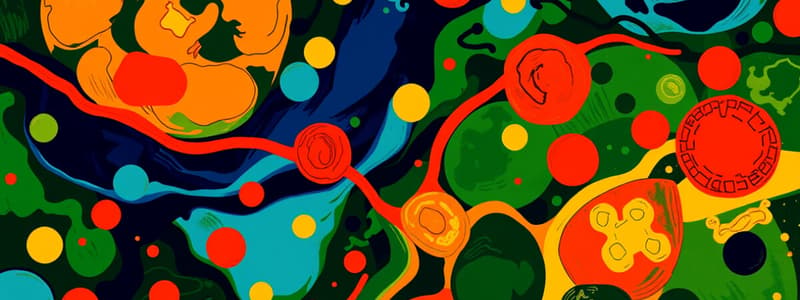Podcast
Questions and Answers
What are the components of a phospholipid and why are phospholipids important?
What are the components of a phospholipid and why are phospholipids important?
Phospholipids consist of two hydrophobic fatty acid tails and a hydrophilic head with a phosphate group. They are important as they form lipid bilayers, which are a major component of all cell membranes.
What do we mean by a 'selectively permeable membrane'?
What do we mean by a 'selectively permeable membrane'?
A selectively permeable membrane restricts movement, allowing some materials to move freely while restricting others.
What are active and passive transport?
What are active and passive transport?
Active transport moves ions from low concentration to high concentration using metabolic energy, while passive transport moves ions from high to low concentration without using energy.
What is diffusion/osmosis?
What is diffusion/osmosis?
What do the terms isotonic, hypotonic, and hypertonic mean?
What do the terms isotonic, hypotonic, and hypertonic mean?
What is the role of proteins in the cell membrane?
What is the role of proteins in the cell membrane?
How do cells bring materials in and out of the cell?
How do cells bring materials in and out of the cell?
How are cells classified?
How are cells classified?
What are the key differences between prokaryotic and eukaryotic cells?
What are the key differences between prokaryotic and eukaryotic cells?
Why is the size of cells constrained?
Why is the size of cells constrained?
What are the four things all cells have in common?
What are the four things all cells have in common?
What is the function of the nucleus organelle?
What is the function of the nucleus organelle?
What do mitochondria do?
What do mitochondria do?
What is the role of ribosomes in cells?
What is the role of ribosomes in cells?
What does the Golgi apparatus do?
What does the Golgi apparatus do?
What is the cytoskeleton and what are its parts?
What is the cytoskeleton and what are its parts?
Flashcards are hidden until you start studying
Study Notes
Phospholipids
- Major components of all cell membranes.
- Composed of two hydrophobic fatty acid tails and a hydrophilic phosphate head.
- Amphiphilic nature allows them to form lipid bilayers.
Selectively Permeable Membrane
- Controls the entry and exit of substances in and out of the cell.
- Types of membranes: impermeable (no movement), permeable (free movement), selectively permeable (restricts certain materials).
Active and Passive Transport
- Passive transport (or diffusion) moves substances from high to low concentration without energy.
- Active transport moves substances from low to high concentration using ATP energy.
- Both processes utilize ion channels for substance movement.
Diffusion and Osmosis
- Osmosis is the diffusion of water across a selectively permeable membrane.
- Water moves from areas of high water concentration to low concentration.
Tonicity: Isotonic, Hypotonic, Hypertonic
- Isotonic solutions have equal solute concentrations inside and outside the cell.
- Hypotonic solutions have lower solute concentrations outside the cell, potentially causing swelling.
- Hypertonic solutions have higher solute concentrations outside the cell, potentially causing shrinkage.
Role of Membrane Proteins
- Peripheral proteins reside on either side of the lipid bilayer.
- Membrane proteins can act as enzymes, receptors, or transporters for materials.
Cellular Intake and Output
- Simple molecules like water, CO2, and O2 cross the membrane via diffusion.
- Diffusion facilitates movement of essential small molecules within cells.
Cell Classification
- Living organisms are composed of cells, classified as prokaryotes and eukaryotes.
- Prokaryotes lack a nucleus and membrane-bound organelles.
Prokaryotic vs. Eukaryotic Cells
- Eukaryotic cells have membrane-bound organelles and a nucleus.
- Prokaryotic cells, like bacteria, lack a nucleus and membrane-bound organelles.
- Eukaryotes can be single-celled (e.g., yeast) or multicellular (e.g., plants, animals).
Constraints on Cell Size
- As cells grow, their surface area-to-volume ratio decreases.
- Larger cells may struggle to cross sufficient materials through the membrane to meet metabolic demands.
Common Features of All Cells
- All cells possess a plasma membrane, cytoplasm, ribosomes, and DNA.
- Plasma membrane encases the cell, controlling the internal environment.
Nucleus
- Known as the "brain" of the cell, directing cellular activities.
- Houses genetic material in the form of chromosomes made of DNA.
Mitochondria
- Organelles responsible for converting food into energy.
Ribosomes
- Sites for protein synthesis within the cell.
Golgi Apparatus
- Functions in the processing, packaging, and distribution of proteins.
Cytoskeleton
- Provides structural support within the cell.
- Composed of a network of protein fibers that determine cell shape and organization.
Studying That Suits You
Use AI to generate personalized quizzes and flashcards to suit your learning preferences.



